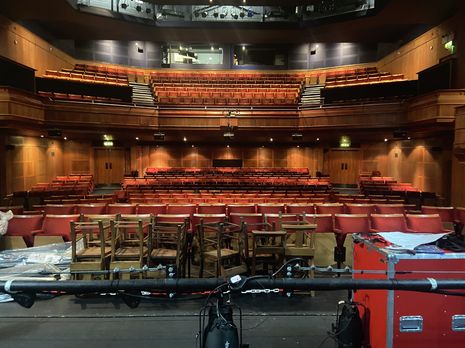Comparing critique: Camdram vs the pros
Zach Lonberg wonders what we bring to the table when we review student dramatics compared with professional tours at the Cambridge Arts Theatre

Students love to criticise theatre. Varsity is no different. And, in Cambridge, where we’re so spoilt by the plethora of productions on offer, there’s always lots to praise and critique. Student productions sit alongside professional ones in artistic atmosphere that encourages abundance. But, if you scroll through the Varsity back-catalogue, you’ll find a strong juxtaposition between reviews of the student scene and those that play at CAT – supposedly the locus of grander, loftier designs by London-bred, oh-so professional touring companies. And the comparison doesn’t tilt in the pros’ favour.
Sandwiched between glowing, four-star homilies of student-written pieces (which, more often than not, were hastily strung together, something I can attest to from personal experience), you’ll find the occasional send-up of a CAT production that, by contrast, has been workshopped for months – by older, trained, and, crucially, paid creatives. Back in April, Sheridan’s The School for Scandal at the Arts Theatre barely scraped half-stars – the headline began with “Egad!”. Equally unimpressed were the reviewers we sent to Frankenstein, The Circle and Macbeth. There are some excellent CAT reviews: I’m responsible for a handful. But compared to the student scene, glowing acclamations are few and far between. My personal favourite act of critique took place last October in our review of A Voyage Round My Father, a touring CAT production starring Rupert Everett. The reviewer’s take? The voyage went “absolutely nowhere”. Ouch.
“The comparison doesn’t tilt in the pros’ favour”
It’s all well and good to chuckle at the phenomenon (and the sheer invective that Cambridge students seem to relish levelling at the pros), but it’s worth thinking more deeply about the relativism embedded in the way we tackle student productions versus those at CAT. There’s simply no way that shows helmed by talented, nationally-renowned artists fall consistently short of capturing what a bunch of (respectfully) nerdy Cam undergrads with limited theatrical experience are able to achieve – much as student theatre-makers would like to think otherwise. So what accounts for the gap?
The simple answer might be obvious: reviewers are able to appreciate the two kinds of production for what they are, respectively. One is a show pieced together by full-time students (none of whom actually study theatre, or have any substantial training), the other is the work of professionals who’ve spent years of time and effort honing their craft. This connects to an experience I’ve had of watching the same play, The 39 Steps, performed at both Pembroke New Cellars and the Arts Theatre. The student version, back in Lent of my first year, flew by its pants in all its madcap glory, which only played into the hands of its comedy. It was silly and self-aware, right down to the aplomb with which Blossom Durr switched between three horrifically shoddy wigs to play different characters – and the audience embraced it all the more as such. By contrast, the CAT production laboured to fill its grandiose performance space with bombastic energy to the same effect – and when flubs occurred, as they did in the Pembroke production, the £30-a-ticket-paying audience were hardly as forgiving.
“Reviewers are able to appreciate the two kinds of production for what they are, respectively”
Which brings me to an important point: audience expectations. Student actors are untrained; slip-ups are to be expected, and politely ignored. Not so for the pros. I’ve seen CAT shows where actors swallow their lines, and it brings the room to a screeching halt. A typical set piece at the Arts Theatre is meticulous and visually sumptuous. This is to be expected, and so it rarely begs a mention in most reviews. By comparison, a design of even half the quality would stand out in any ADC coverage, and help adjust for a show that was otherwise shoddy at the seams. Would a similar triumph of style over substance save a CAT review? In student dramatics, strong technical feats can be an active contributor to a show’s rating; by contrast, professional production values only register in their absence or deficiency, never positively.
And perhaps this is what differentiates CAT from Camdram the most. Innately, it seems, we approach student theatre with a constructive scheme of evaluation; at professional theatres, we’re more punitive. For all Camdram’s prestige, when we sit down to student shows, we tend to leave our expectations at the door. We mark upwards, basing our assessment on the observations we gather as the performance chugs along. And the contrast with CAT, where we arrive with an assumption of perfection, and mark backwards for every flaw we spot, might not just be coincidence.
Maybe, just maybe, it’s because of our approach to Camdram that we flip the script at the Arts Theatre; as the surroundings and the stakes shift, then so too must our means of response. Whatever the cause of this recalibration, its by-product is evident in the mish-mash of criticism that decorates the Varsity records. At the very least, there’s a silver lining for students in this – if your last show was above two stars, you’re faring better than Rupert Everett.
 Comment / Plastic pubs: the problem with Cambridge alehouses 5 January 2026
Comment / Plastic pubs: the problem with Cambridge alehouses 5 January 2026 News / Cambridge academics stand out in King’s 2026 Honours List2 January 2026
News / Cambridge academics stand out in King’s 2026 Honours List2 January 2026 News / Cambridge businesses concerned infrastructure delays will hurt growth5 January 2026
News / Cambridge businesses concerned infrastructure delays will hurt growth5 January 2026 News / AstraZeneca sues for £32 million over faulty construction at Cambridge Campus31 December 2025
News / AstraZeneca sues for £32 million over faulty construction at Cambridge Campus31 December 2025 Interviews / You don’t need to peak at Cambridge, says Robin Harding31 December 2025
Interviews / You don’t need to peak at Cambridge, says Robin Harding31 December 2025










